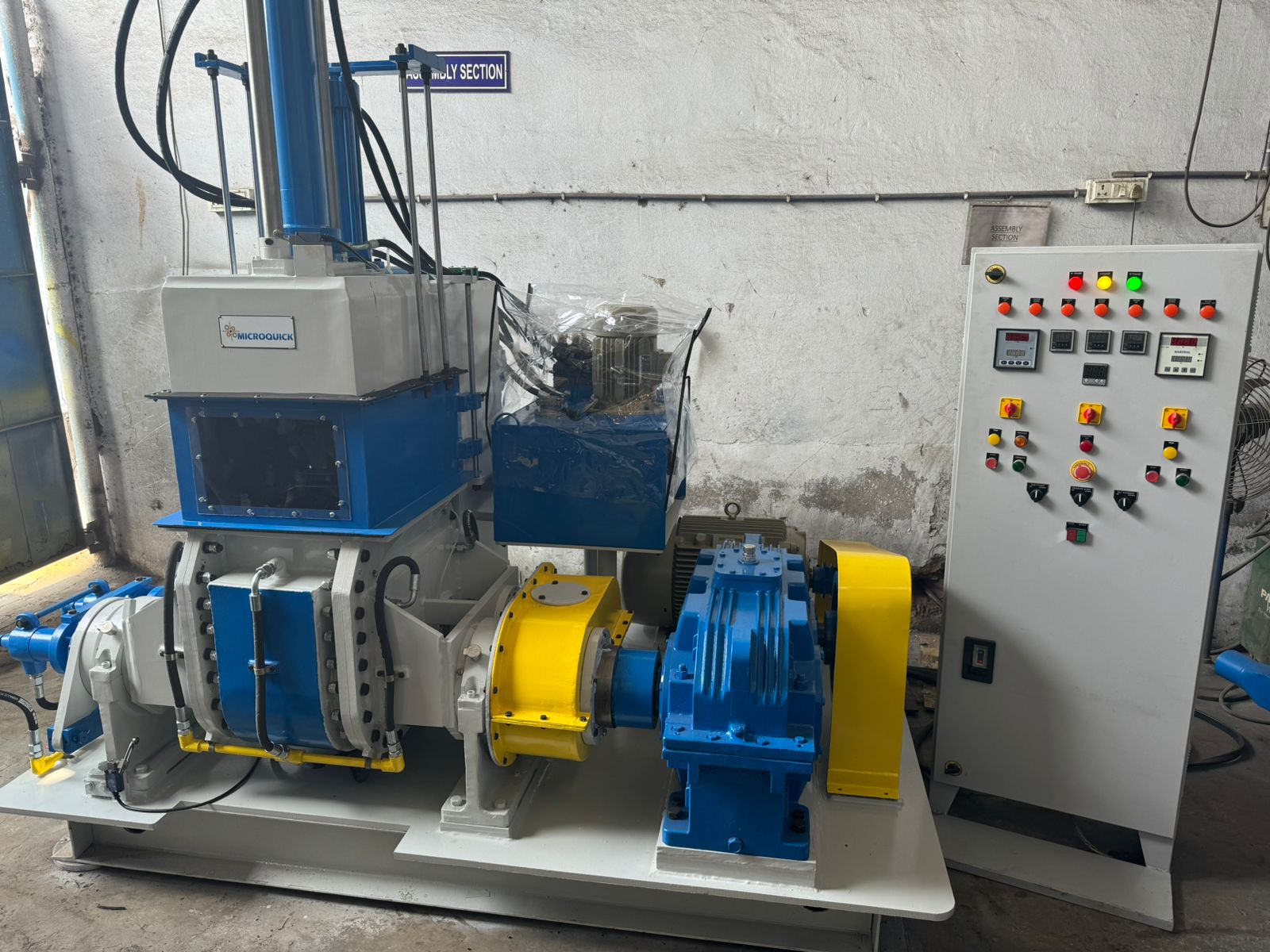Efficiency is crucial in rubber mixing processes as it saves time, resources, and ensures consistent quality and performance in the final product. One effective way to achieve this efficiency is by using a rubber mixer. A rubber mixer plays a significant role in achieving desired properties in the final product by facilitating efficient dispersion of ingredients and homogeneous blending of polymers.
Key Objectives of Rubber Compounding
Rubber compounding has several key objectives:
-
Consistency in quality and performance
-
Improving production efficiency
By maximizing efficiency in rubber mixing, manufacturers can ensure that each batch of rubber compound meets the required specifications, resulting in products that perform consistently and meet customer expectations.
Factors to Consider for Maximizing Quality and Performance
To achieve the objectives of rubber compounding, several factors need to be considered:
-
Selecting appropriate rubber mixing equipment
-
Optimizing mixing parameters
-
Proper maintenance and care of mixing equipment
-
Advances in rubber mixing technology, such as tandem technology and energy-efficient mixing equipment
These factors play a crucial role in maximizing quality and performance in rubber mixing processes.
Recent Developments in Rubber Mixing Technology
Recent developments in rubber mixing technology have contributed to improving mixing efficiency. Some of these developments include:
-
Tandem technology
-
Energy-efficient mixing equipment
These advancements in technology have further enhanced the efficiency of rubber mixing processes.
The Different Types of Rubber Mixing Equipment
When it comes
to rubber mixing equipment
, there are several different types that serve specific purposes. These include internal rubber mixers,
hydraulic dispersion kneaders
, twin screw sheeters, and mixing mills. Each type of equipment plays a vital role in the mixing process and has a significant impact on efficiency.
Internal Rubber Mixers
Internal rubber mixers are designed to blend rubber compounds efficiently by using a rotating chamber and a set of interlocking rotors. This type of mixer ensures the dispersion of ingredients and the homogeneous blending of polymers, which are crucial for achieving the desired properties in the final product. The efficient dispersion of ingredients ensures that all components are evenly distributed, resulting in consistent quality and performance.
Hydraulic Dispersion Kneaders
Hydraulic dispersion kneaders, such as Microquick Engineers’ Hydraulic Dispersion Kneaders, offer exceptional compounding performance. These kneaders use automated continuous hydraulic ram pressure on ingredients to ensure thorough mixing. With batch preparation times ranging from 7 to 12 minutes, these kneaders contribute to efficient production. The dispersion capabilities of these kneaders are also noteworthy, as they provide excellent dispersion of ingredients, leading
to consistent quality compounding
.
Twin Screw Sheeters
Another key component of rubber mixing equipment is the twin screw sheeter. This equipment is specifically designed to process rubber compounds with high filler content. It uses two counter-rotating screws to blend the rubber and fillers, resulting in a homogenous mixture. The twin screw sheeter is particularly useful for producing hard batches and ensures operational convenience.
Mixing Mills
Mixing mills are also essential
in the rubber mixing process
. They consist of two counter-rotating rolls that work together to mix and process rubber compounds. Mixing mills are used to refine the mixture obtained from the internal mixer, ensuring that all ingredients are thoroughly mixed. These mills also play a crucial role in controlling the temperature during the mixing process, as the heat generated during mixing can impact the properties of the final product.
Overall, understanding the different types of rubber mixing equipment and their respective roles in the mixing process is essential for maximizing efficiency. Each component, whether it be internal rubber mixers, hydraulic dispersion kneaders, twin screw sheeters, or mixing mills, contributes to the overall quality and performance of the final rubber product. By selecting the appropriate equipment and optimizing the mixing parameters, manufacturers can ensure consistent quality, improved production efficiency, and ultimately, the success of their rubber mixing operations.
Maximizing Efficiency with a Rubber Mixer
Efficient dispersion of ingredients, homogeneous blending of polymers, and temperature control are essential principles in maximizing efficiency with a rubber mixer. These factors play a crucial role in achieving consistent quality, improving production efficiency, and reducing costs in various industries.
Efficient Dispersion of Ingredients
- Thorough distribution of ingredients within the rubber mixture
- Uniform distribution eliminates clumps and inconsistencies
- Enhanced properties and improved performance of the final product
Homogeneous Blending of Polymers
- Proper integration of different polymers for a uniform mixture
- Consistent properties throughout the final product
- Desired characteristics and performance of the rubber product
Temperature Control
- Affects viscosity and flow characteristics of the rubber compound
- Impact on dispersion and blending of ingredients
- Maintaining optimal temperature enhances efficiency
To maximize efficiency with a rubber mixer, manufacturers should focus on these principles. By ensuring efficient dispersion of ingredients, homogeneous blending of polymers, and proper temperature control, consistent quality, improved production efficiency, and cost reduction can be achieved.
Microquick Engineers’ Hydraulic Dispersion Kneaders
Microquick Engineers, a leading manufacturer and exporter of Hydraulic Dispersion Kneaders, offers innovative solutions that address these principles. Their kneaders are designed to provide excellent compounding performance through automated continuous hydraulic ram pressure on ingredients. Key features include:
- Batch preparation times as low as 7-12 minutes
- Excellent dispersion of ingredients and consistent quality compounding
- High-quality rubber products
- Suitable for various industries
- Durable and long-lasting mixing chamber and rotors
- Innovative shaft seals with lubrication passage to prevent ingredient leakage
- Low energy consumption for cost-effectiveness
The Key Aspects of Maximizing Rubber Mixing Quality and Performance
When it comes
to maximizing the quality and performance
of rubber mixing, there are several factors that need to be considered. In this section, we will explore three key aspects:
- Selecting the appropriate rubber mixing equipment
- Optimizing mixing parameters
- Ensuring proper maintenance and care of the equipment
Selecting the Appropriate Rubber Mixing Equipment
Selecting the right
rubber mixing equipment
is crucial in achieving desired results. It is important to consider specific requirements and industry needs when making this decision. Different types of equipment offer unique advantages and are suitable for different applications:
-
Internal Rubber Mixers:
Provide advantages XYZ. -
Hydraulic Dispersion Kneaders:
Offer excellent compounding performance with automated continuous hydraulic ram pressure on ingredients. They provide efficient production with batch preparation times of 7-12 minutes, ensuring consistent quality compounding. Microquick Engineers is a trusted provider of hydraulic dispersion kneaders. -
Twin Screw Sheeters:
Suitable for XYZ applications. -
Mixing Mills:
Offer XYZ advantages.
Optimizing Mixing Parameters
Once the appropriate equipment is selected, optimizing mixing parameters becomes essential for maximizing efficiency and quality. Key objectives in rubber mixing include:
- Efficient dispersion of ingredients
- Homogeneous blending of polymers
- Controlling the temperature during the mixing process
By carefully adjusting parameters such as mixing speed, rotor configuration, and temperature, manufacturers can achieve better dispersion and blending, resulting
in improved product quality
.
Ensuring Proper Maintenance and Care
Proper maintenance and care of mixing equipment are vital for ensuring consistent performance. Regular inspections, cleaning, and lubrication of the equipment can help prevent issues such as wear and tear, leakage, and breakdowns. For example, Microquick Engineers’
hydraulic dispersion kneaders
feature innovative shaft seals with lubrication passage to prevent ingredient leakage.
These maintenance practices not only extend the lifespan of the equipment but also contribute to consistent and reliable performance.
Selecting the appropriate rubber mixing equipment, optimizing mixing parameters, and maintaining the equipment are key factors in maximizing
the quality and performance of rubber
mixing. By considering specific requirements, utilizing advanced technologies, and implementing proper maintenance practices, manufacturers can achieve efficient production, consistent quality, and improved overall performance.
Whether it’s selecting the right equipment or optimizing mixing parameters, it’s important to prioritize these factors to ensure successful rubber mixing operations.
Advances in Rubber Mixing Technology
Advances
in rubber mixing technology
have greatly contributed to improving mixing efficiency in the industry. With the continuous development of technology, manufacturers have focused on finding innovative solutions to enhance the mixing process and optimize productivity.
Tandem Technology
One recent development in rubber mixing technology is the use of tandem technology. Tandem technology involves the use of multiple mixers in a series, allowing for a more efficient and thorough mixing process. By utilizing two or more mixers in tandem, manufacturers can achieve better dispersion of ingredients and ensure a more homogeneous blend of polymers. This technology has proven to be highly beneficial in improving the overall
quality and performance of rubber
compounds.
Benefits of Tandem Technology
-
Improved Temperature Control:
Tandem technology allows for better control of temperature during the mixing process. The use of multiple mixers enables manufacturers to maintain optimal temperature levels, ensuring that the rubber compounds are mixed at the right temperature for optimal performance. This leads to improved consistency and quality in the final product. -
Enhanced Ingredient Dispersion:
Tandem technology enhances the dispersion of ingredients, resulting in more efficient mixing. The use of multiple mixers allows for better distribution of additives and fillers throughout the rubber compound, ensuring that all components are thoroughly mixed. This leads to improved batch-to-batch consistency and reduces the risk of product defects.
Energy-Efficient Mixing Equipment
In addition to tandem technology, the industry has also witnessed the development of energy-efficient mixing equipment. This equipment is designed to minimize energy consumption while maximizing mixing efficiency. By utilizing advanced technologies
such as variable speed drives
and energy recovery systems, energy-efficient mixers can significantly reduce energy costs and environmental impact.
Benefits of Energy-Efficient Mixing Equipment
-
Cost Savings:
The positive impact of energy-efficient mixing equipment on efficiency and cost savings cannot be overstated. By reducing energy consumption, manufacturers can lower their operating costs and improve their overall profitability. -
Sustainability:
Additionally, the use of energy-efficient equipment aligns with sustainability goals, making it an attractive option for environmentally conscious companies.
Rubber Mixing Equipment: Impact and Use Cases
Rubber mixing equipment plays a crucial role in various industries, including automotive, industrial, consumer products, healthcare, and electrical. These industries rely on rubber mixers to maximize efficiency and improve product quality . Let’s explore some specific use cases where rubber mixers have made a significant impact.
Automotive Industry
In the automotive industry, rubber mixers are used in the production of various rubber parts, such as tires, hoses, and seals. By using high-quality rubber mixing equipment, manufacturers can ensure that these parts meet the required standards for durability, performance, and safety. Rubber mixers are essential in achieving the desired properties of automotive rubber parts , such as resistance to heat, chemicals, and wear. The precise control of temperature during the mixing process ensures that the rubber compounds maintain their integrity and perform optimally in different automotive applications.
Consumer Products Industry
In the consumer products industry, rubber mixing equipment is used in the production of a wide range of products, including rubber gloves, footwear, and household items. Rubber mixers help manufacturers achieve consistent quality and performance in their products. For instance, in the production of rubber gloves, rubber mixers ensure efficient dispersion of ingredients, resulting in gloves with excellent elasticity, strength, and comfort. By using rubber mixers, manufacturers can maintain the desired consistency in the properties of their products, ensuring customer satisfaction and safety.
Healthcare Industry
The healthcare industry also benefits from rubber mixing equipment, particularly in the production of medical devices and equipment. Rubber mixers are used to create specialized rubber compounds that meet the stringent requirements of the healthcare industry. For example, medical-grade rubber mixers ensure that the rubber compounds used in the production of medical devices, such as catheters and surgical gloves, are free from contaminants and possess the necessary properties for safe and effective use in healthcare settings. Rubber mixers also enable manufacturers to produce medical devices with consistent quality, ensuring reliability and patient safety.
Electrical Industry
In the electrical industry, rubber mixing equipment is essential for the production of electrical insulation materials, such as cables and wires. Rubber mixers help achieve homogeneous blending of polymers, ensuring that the insulation materials have the desired electrical properties, such as resistance to high voltages and insulation efficiency. By using rubber mixers, manufacturers can produce high-quality insulation materials that meet the stringent requirements of the electrical industry, ensuring the safety and reliability of electrical systems.
Overall, rubber mixing equipment plays a vital role in various industries, enabling manufacturers to maximize efficiency and improve product quality. Whether it’s in the automotive, consumer products, healthcare, or electrical industry, rubber mixers ensure consistent quality, precise control of properties, and efficient dispersion of ingredients. By investing in high-quality rubber mixing equipment, manufacturers can meet the demands of their respective industries and deliver products that meet the highest standards of performance and safety.
Maximizing Efficiency with Microquick Engineers’ Hydraulic Dispersion Kneaders
When it comes to achieving consistent quality and improving production output in rubber mixing, maximizing efficiency is crucial. Microquick Engineers, a leading manufacturer and exporter of Hydraulic Dispersion Kneaders, offers a solution that ticks all the boxes.
Here are some key features of Microquick Engineers’ Hydraulic Dispersion Kneaders:
- Excellent Compounding Performance: These kneaders provide excellent compounding performance with automated continuous hydraulic ram pressure on ingredients. This results in batch preparation times of 7-12 minutes, ensuring efficient production and guaranteeing excellent dispersion of ingredients and consistent quality compounding.
- Operational Convenience: Microquick Engineers’ kneaders are convenient for producing hard batches and have wear resistance properties in the mixing chamber and rotors, ensuring durability. The innovative shaft seals with lubrication passage prevent ingredient leakage, further enhancing the efficiency of the mixing process.
- Energy Efficiency: These kneaders have low energy consumption, making them energy-efficient and cost-effective.
To learn more about Microquick Engineers’ Hydraulic Dispersion Kneaders and how they can maximize efficiency in your rubber mixing process , visit their website. They have a video library showcasing their products and positive testimonials from satisfied customers. You can also find valuable resources on the website, such as tips for optimizing performance and efficiency of your dispersion mixer, enhancing the quality of your automotive rubber parts, and understanding the importance of energy efficiency in rubber processing equipment.
Don’t miss out on the opportunity to revolutionize your rubber mixing process and take your production to new heights. Visit Microquick Engineers’ website today and discover how their Hydraulic Dispersion Kneaders can help you achieve maximum efficiency and superior quality in your rubber compounding .


